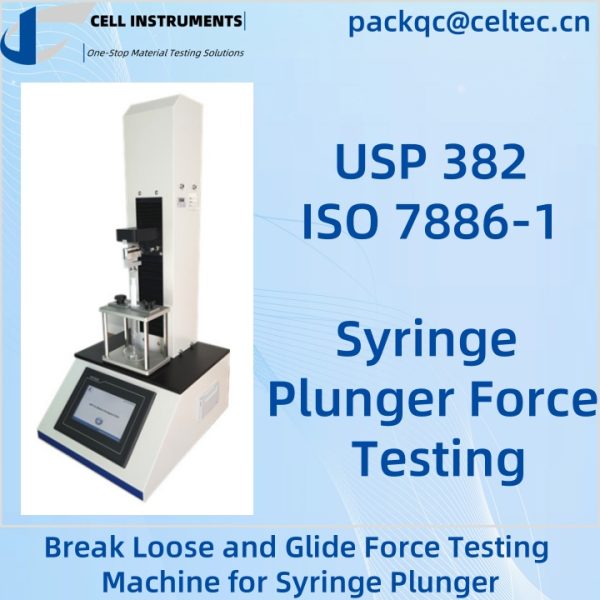Prueba de fuerza de deslizamiento y desprendimiento
—— USP 382 e ISO 7886-1
Importancia de las pruebas de fuerza de deslizamiento y de desprendimiento
Las pruebas de fuerza de desprendimiento y deslizamiento son un proceso fundamental en el control de calidad de los envases y dispositivos médicos, en particular en las jeringas. Esta prueba mide la fuerza necesaria para iniciar el movimiento (fuerza de desprendimiento) y mantener el movimiento (fuerza de deslizamiento) mientras se acopla el émbolo de la jeringa. La importancia de estas pruebas radica en su función de garantizar un funcionamiento suave, la seguridad y el rendimiento, especialmente en aplicaciones farmacéuticas y médicas donde la precisión es esencial.
Las pruebas de fuerzas de deslizamiento y desprendimiento garantizan que las jeringas funcionen de manera uniforme en diversas condiciones. Al cumplir con el estándar de la industria USP 382Los fabricantes pueden garantizar que sus productos cumplan las especificaciones necesarias para su uso en aplicaciones médicas y farmacéuticas.
Fuerza de desprendimiento vs. fuerza de deslizamiento
Es importante distinguir entre la fuerza de desprendimiento y la fuerza de deslizamiento, ya que ambas tienen implicaciones distintas para el rendimiento de la jeringa:
- Liberarse de la fuerza:La fuerza inicial necesaria para romper el sello entre el émbolo y el cuerpo. Esta fuerza garantiza que la jeringa no tenga fugas ni funcione mal cuando se use por primera vez.
- Fuerza de planeo:La fuerza continua necesaria para mantener el émbolo en movimiento después de la liberación inicial. Garantiza que la jeringa administre el medicamento de manera uniforme, sin sacudidas repentinas ni flujo irregular.
Ambas fuerzas se miden por separado, pero son esenciales para comprender el rendimiento general de la jeringa. La calibración adecuada de ambas fuerzas garantiza un uso suave y confiable.
Normas para la prueba de fuerza de la jeringa
USP 382 y ISO 7886-1 Son normas clave que describen los requisitos para probar la fuerza del émbolo de la jeringa. Estas normas garantizan que las jeringas cumplan con los criterios de alto rendimiento y seguridad. La USP 382 se centra en los requisitos funcionales de las jeringas, mientras que el Anexo E de la ISO 7886-1 especifica los métodos de prueba para determinar las fuerzas necesarias para operar el pistón de la jeringa, incluida la prueba de fuerza de empuje del émbolo.
USP 382 Prueba de fuerza de deslizamiento de la jeringa
- Objetivo: Garantizar la funcionalidad y seguridad de la jeringa.
- Parámetros: Fuerza inicial, fuerza máxima, fuerza sostenida.
- Significado: El cumplimiento garantiza un rendimiento confiable de la jeringa en entornos clínicos.
ISO 7886-1 Prueba de fuerza de deslizamiento de la jeringa Anexo E
- Objetivo: Mida la fuerza necesaria para mover el émbolo a través del cilindro de la jeringa a una velocidad controlada.
- Procedimiento: Coloque la jeringa en el probador y mueva el émbolo a una velocidad predeterminada.
- Parámetros: Se miden las fuerzas iniciales, máximas y sostenidas y se comparan con los límites estándar.
- Significado: Garantiza que las jeringas cumplan con los requisitos de fuerza, cruciales para la seguridad y la funcionalidad.
Cómo medir la fuerza de deslizamiento al soltarse
- Preparación:La jeringa se asegura en una máquina de pruebas y el émbolo se coloca en posición para la prueba.
- Medición de fuerza de desprendimiento:Se mide la fuerza inicial necesaria para romper el sello del émbolo. Esto se conoce como “fuerza de desprendimiento” o fuerza necesaria para iniciar el movimiento del émbolo.
- Medición de la fuerza de deslizamiento:Después de que el émbolo se mueve, la prueba mide la fuerza continua necesaria para mantenerlo en movimiento suave. Esto se denomina “fuerza de deslizamiento”.
- Condiciones de prueba:La prueba normalmente se realiza en condiciones ambientales controladas, como la temperatura, para garantizar que los resultados reflejen el uso en el mundo real.
Equipo de prueba para pruebas de fuerza de deslizamiento y de desprendimiento
El comprobador de fuerza de deslizamiento MST-01 de Cell Instruments está diseñado para satisfacer las rigurosas demandas de las pruebas de dispositivos médicos. Proporciona mediciones precisas de la fuerza necesaria para empujar el émbolo de una jeringa, lo que garantiza que cada jeringa cumpla con los altos estándares de rendimiento y seguridad requeridos en aplicaciones médicas y farmacéuticas.
Especificaciones técnicas del MST-01
| Campo de pruebas | 50N (o según sea necesario) |
| Ataque | 200 mm (sin abrazadera) |
| Prueba de velocidad | 1 ~ 500 mm/min |
| Precisión de desplazamiento | 0,01 mm |
| Exactitud | 0,5% FS |
| Producción | Pantalla, microimpresora, RS232 (opcional) |
| Fuerza | 110 ~ 220 V |
Principales características y beneficios
- Fiabilidad y precisión: Alta precisión y confiabilidad con control PLC.
- Facilidad de uso: Interfaz fácil de usar para todos los niveles.
- Durabilidad: Construido con materiales de alta calidad para uso a largo plazo.
- Atención al cliente: Soporte integral para instalación, capacitación y mantenimiento.
Preguntas frecuentes sobre pruebas de fuerza de deslizamiento y de desprendimiento
A1: La prueba de fuerza de ruptura mide la fuerza necesaria para iniciar el movimiento de un émbolo de jeringa dentro del cilindro.
A2: La prueba de fuerza de deslizamiento garantiza que el émbolo de la jeringa se mueva suavemente sin fuerza excesiva, lo cual es crucial para una administración precisa y segura del medicamento.
A3: El MST-01 mide la fuerza necesaria para empujar el émbolo de la jeringa, proporcionando datos y análisis en tiempo real para garantizar que las jeringas cumplan con los estándares de rendimiento.
A4: USP 382 e ISO 7886-1 son las normas clave que describen los requisitos para probar la fuerza del émbolo de la jeringa.
A5: Sí, Cell Instruments ofrece opciones de personalización para adaptar el probador a diferentes tamaños de jeringas e integrar funciones adicionales.



